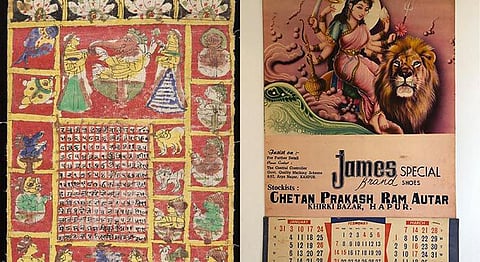
- HOMEGROWN WORLD
- #HGCREATORS
- #HGEXPLORE
- #HGVOICES
- #HGSHOP
- CAREERS
- ABOUT US
- CONTACT US

India adores its calendars. These cultural time-pieces have been gifted to each one of us in almost every institution, to the point where companies started creating their own merchandised calendars. Hanging over almost every cash register, tea stall, government office and school, a particular design selection by a person can speak of their unique quirks, choices and personality. Although the question remains; are these relics relevant to young Indian Millennials and Gen-Z?
I faintly remember getting calendars as gifts from my uncles who had their own businesses and smaller ones from doctors. Calendars with Sikh history were also available at stalls outside Gurudwara. One can notice how these pieces always sold a particular idea to us; omnipresent in our homes while their gaze follows us around throughout the day.
Calendars in the Indian context have a strong religious gaze as well. The Hindu calendar system known as Panchangam is followed around the subcontinent as well as by South Asian communities abroad. While the system in itself dictates our holidays and governs the dates for all the important ceremonies, the visual story of these calendars also plays an important role in the culture.
The depiction of Hindu deities in these mass-produced calendars offers a personal shrine to each individual. Present in every nook and corner of our marketplace these images become ubiquitous in Indian public spaces, playing a significant role in the sudden surge in images of mythological tales; including the famous Indian comic Amar Chitra Katha.
They formed the visual culture of the country, imprinting images of Gau-Mata (holy cow) on all minds. According to the book ‘Gods in the Bazaar: The Economies of Indian Calendar Art’ written by Kajri Jain, one of the quintessential images of Indian calendar art is a picture of Saraswati, the Hindu goddess of wisdom, painted by the nobleman artist Raja Ravi Varma in 1881.
Known as the ‘father of Indian calendar art’, Raja Ravi Varma was responsible for popularising and bringing the culture to the masses. His prints are the reason the Gods became accessible to the common man and became decorative symbols in our homes. The work of his contemporaries like Hem Chander Bhargava, B.G Sharma, L.N Sharma,Yogendra Rastogi, and others also became popular in Indian calendars.
During the freedom struggle, revolutionary ideas were often communicated through the images on calendars; carrying prints of Mother India as a symbol of resistance with other artwork signifying liberation and patriotic portraits of the national heroes of the time. The ease of production and cheap cost helped the visual mass culture reach populations at large without getting labelled as ‘propaganda’. This era of calendar art was soon replaced with photographic reprints but the idea of communicating a visual story remained strong.
The impact of Kingfisher calendars was strong in the early 2000s; dominating the cultural zeitgeist of the time with models posing in exotic foreign locations and luxury resorts. Although these pieces marketed an unattainable image for women, they did change the idea of religious femininity, replacing the image of the ‘proper’ Indian woman.
Many other firms such as Maruti and Tata group also followed their lead and introduced similar calendars in their marketing strategies. The calendars placed in our rooms soon became a vision to be achieved, carrying images of foreign locations and other markers of success, all being sold to us by different companies.
In the present day, many young designers and illustrators are creating contemporary versions of calendars. Sudheesh Chandran created calendars with modern-day icons such as Arundhati Roy and other icons of Indian art history such as Amrita Shergill, while many other young creators on social media platforms like to create digital calendars relevant to the young people of today.
These merchandise articles are not going away any time soon. Their mediums tend to evolve over time but the relevance remains strong across the Indian visual culture; changing every decade and pushing forward the unique ideas of the time. As gifts, mementoes, personal shrines, or political messages, Indian calendars and their visuals leave behind irreplaceable traces of history in every era and are here to stay.
If you enjoyed reading this, we also suggest:
